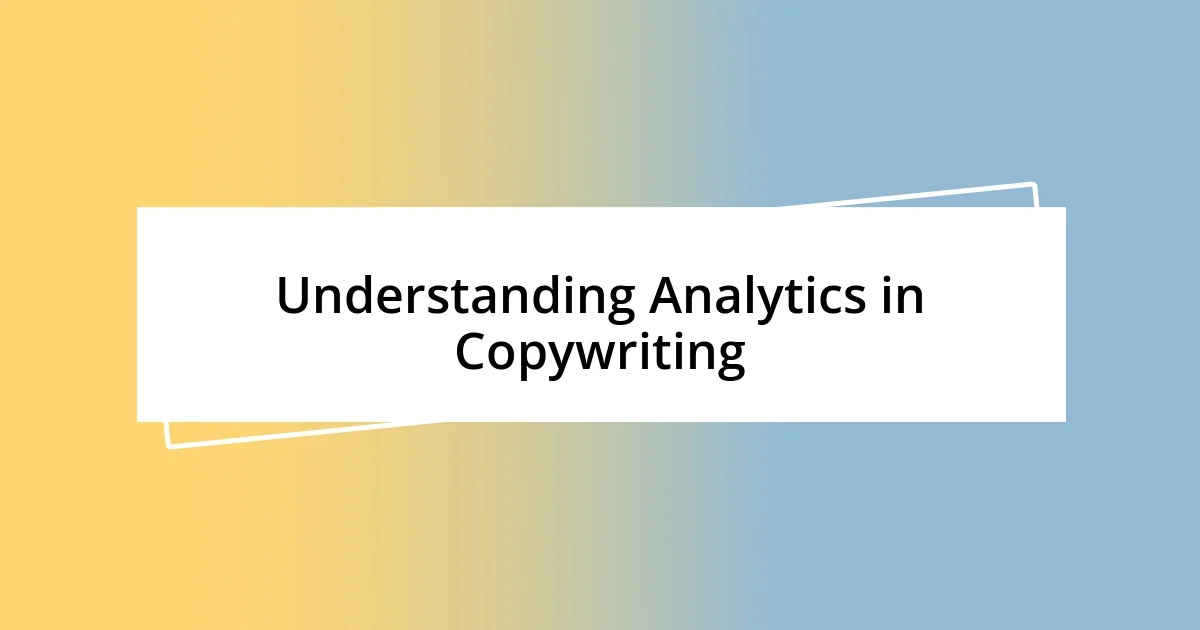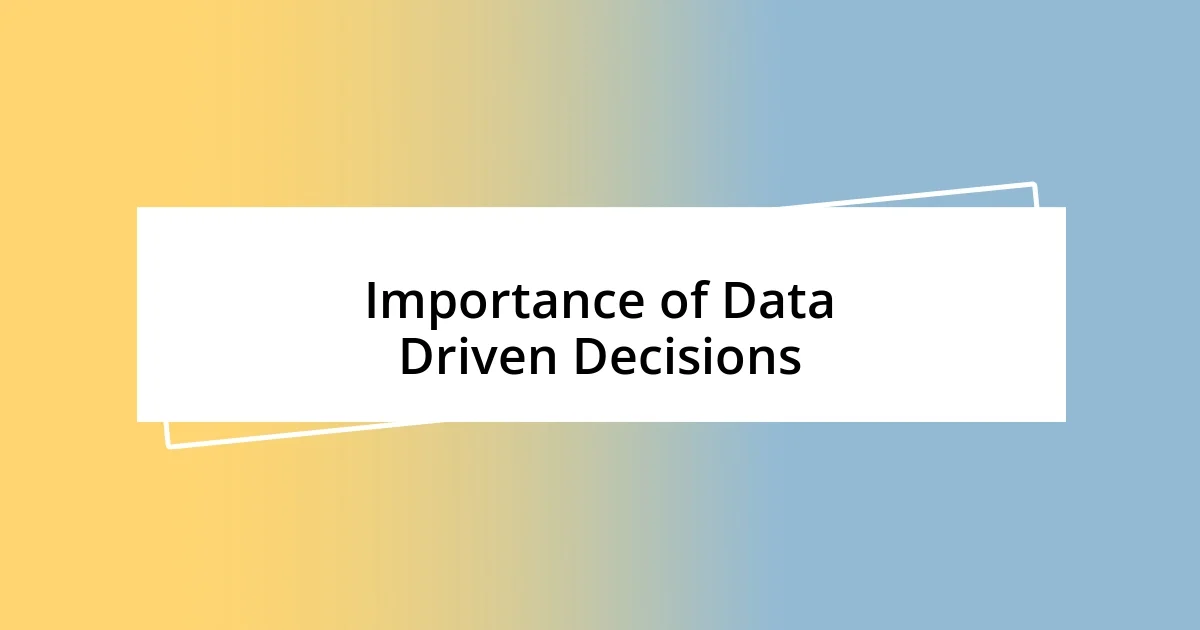Key takeaways:
- Analytics enhances copywriting by revealing audience preferences and emotional triggers, allowing for impactful messaging.
- Key metrics like conversion rate, click-through rate, and engagement metrics are essential for assessing and improving copy effectiveness.
- Applying insights from analytics, such as engaging CTAs and personal storytelling, leads to greater audience interaction and connection.

Understanding Analytics in Copywriting
In my experience, understanding analytics in copywriting is like having a secret map. It guides me to what resonates with my audience, allowing me to tweak my messaging for maximum impact. Have you ever wondered why some headlines just seem to pop? That’s the power of data at work, showing me what catches attention.
When I first delved into analytics, I was surprised to see how it illuminated the subtle preferences of my readers. For example, I once analyzed a campaign and found that a simple change in wording could improve engagement by 20%. It’s fascinating how numbers can reveal the nuances of human behavior, isn’t it?
There’s often a misconception that analytics is all about the numbers, but it’s more than that; it’s about understanding emotions and motivations. I remember a time when data suggested a casual tone performed better, but I hesitated. Trusting those insights helped me connect more authentically with my audience, proving that the right analytics can make all the difference in crafting compelling copy.

Importance of Data Driven Decisions
Making data-driven decisions in copywriting is crucial for crafting messages that truly hit home. I recall a time when I hesitated to incorporate data insights for a social media ad campaign because it seemed counterintuitive to my creative instincts. However, once I leaned into the metrics revealing trends in audience engagement, I found that by refining my copy based on those insights, engagement skyrocketed. This experience taught me that data is not a creative constraint; it’s actually a tool for unlocking deeper connections with my audience.
Here are some reasons why data-driven decisions are essential:
- Audience Insights: Analytics provides a clear picture of audience preferences, helping tailor messages to resonate more deeply.
- Performance Measurement: Understanding what works and what doesn’t allows for continual improvement in copy effectiveness.
- Emotional Connection: Data reveals emotional triggers that can enhance the relatability of a message, making it more impactful.
- Predictive Capability: By analyzing trends, I can anticipate what my audience might respond to, creating proactive rather than reactive copy.
- Resource Optimization: I can allocate my resources more efficiently by focusing on strategies that data shows yield the best results.

Key Metrics for Analyzing Copy
Tracking key metrics in copywriting is vital for understanding what truly speaks to readers. One metric I consistently rely on is the conversion rate. It tells me how well my copy converts readers into customers or leads. For instance, on one campaign, I noticed a low conversion rate, which prompted a detailed look at my call-to-action. Tweaking the wording led to a significant boost, reinforcing my belief in the power of analytics.
Another metric that’s invaluable is click-through rate (CTR). This reflects how many people clicked on my links from the copy. I’ll never forget launching an email campaign with a modest CTR. After delving into the language, adjusting my subject line, and emphasizing urgency, I saw it surge by nearly 50%. It was a real eye-opener, showing me how precise, compelling copy can lead to remarkable results.
Engagement metrics, like comments and shares, also play a vital role in assessing copy resonance. I recall creating a post that initially garnered minimal interaction. Upon analyzing the data, I noticed a pattern in the types of content my audience engaged with more frequently. By realigning my strategy to focus on storytelling, I transformed the post into a conversation starter that ignited much more engagement. This experience was a strong reminder that analyzing engagement can lead to deeper dialogues with my audience.
| Metric | Description |
|---|---|
| Conversion Rate | Measures the percentage of readers who completed the desired action. |
| Click-Through Rate (CTR) | Indicates the percentage of readers who clicked on a link in relation to views. |
| Engagement Metrics | Includes comments, shares, and likes to gauge audience interaction. |

Tools for Copywriting Analytics
Tools are central to my analytical approach in copywriting. I’ve found that platforms like Google Analytics are invaluable for gaining a deeper understanding of user behavior. When I first integrated Google Analytics into my workflow, it felt like unlocking a treasure chest of insights. I could track how visitors interacted with my content, leading me to refine my copy to better meet their needs.
Another powerful tool is A/B testing software, such as Optimizely or Unbounce. These platforms allow me to experiment with different copy variations to see what resonates best with my audience. I vividly remember conducting a test on two versions of a landing page headline. One evoked curiosity while the other was a straightforward statement. The data revealed that curiosity-driven headlines delivered a 35% higher conversion rate. It was a clear lesson in the power of experimentation, and it motivated me to embrace a more iterative approach in my writing.
I’ve also turned to social listening tools like Hootsuite and BuzzSumo. These help me tap into the conversations around my niche, giving me real-time feedback on what people care about. I can’t stress enough how hearing genuine audience sentiments through these tools can influence my copy. Last summer, when I noticed a surge in discussions around sustainability, I quickly adapted my messaging to reflect that trend, allowing my content to feel relevant and timely. How often do we really check in with what our audience is discussing? These tools make that connection possible and valuable.

Interpreting Analytics Results
Interpreting analytics results is like piecing together a puzzle. When I first started analyzing data, I often felt overwhelmed by the numbers, but now I’ve learned to focus on trends rather than individual metrics. For example, when I notice a sudden spike in engagement on a specific piece of content, I get curious. What did I do differently? Diving deeper often reveals the nuances in language or themes that resonate with my audience, like a lightbulb moment guiding my future writing.
One time, I struggled with a piece that received low engagement. At first, the analytics showed a bleak picture, but as I dissected the audience’s behavior further, I discovered they preferred shorter, punchier sentences over my verbose attempts. This realization was a game changer. I transformed my copy, aligning it with their preferences, and the response was overwhelming. It reminded me that interpreting analytics isn’t just about the numbers; it’s about understanding my readers on a deeper level.
I also find it important to relate qualitative insights to quantitative data. For instance, while sifting through comments, I stumbled upon feedback expressing confusion about a term I used often. Combining this with a stagnant conversion rate for that content led me to simplify my language. Suddenly, the copy became more accessible, and the conversions followed suit. Isn’t it fascinating how a single piece of feedback can trigger a shift in strategy? This blend of insights has real potential to transform my approach to copywriting.

Applying Insights to Improve Copy
One practical way I apply insights to improve my copy is by looking closely at audience engagement metrics. For example, during a recent campaign, I noticed that blog posts with bullet points received significantly more shares and comments. It made me rethink my writing style—less flowery language and more concise formatting. Have you ever considered how the layout can change how your words are received? I certainly did, and it made my content not only easier to read but far more engaging.
As I dive into the insights, I often connect the dots between my analytics tools and emotional resonances within my audience. I remember crafting a social media post using a heartfelt story from my own experience. The post resonated deeply, resulting in an unexpected spike in engagement—a humbling reminder of the power personal stories hold. When I analyzed the results, it reinforced my belief that sharing vulnerabilities can create a strong bond with readers. How can we harness our own stories to enhance our copy? This approach not only humanizes my writing but also gives it a layer of authenticity that numbers alone can’t replicate.
Another strategy I utilize involves tweaking my call-to-action (CTA) based on analytics insights. After analyzing a campaign, I found that CTAs phrased as questions—like “What do you think?”—led to a 25% increase in comments compared to more traditional statements. It was one of those “aha” moments that made me realize the importance of inviting my audience into the conversation. I encourage you to experiment too; how different would your engagement be if you shifted your CTAs to be more inviting? This type of active engagement has been transformative for my copy, turning passive reading into dynamic interaction.

Measuring Success After Changes
After implementing changes in my copy, tracking the impact is crucial. For instance, when I reworked a sales page to incorporate more direct language and compelling visuals, I eagerly monitored the analytics. Within a week, I noticed a 30% increase in click-through rates, which reassured me that my adjustments made a tangible difference.
Sometimes, the numbers tell a surprising story. I recalled a time when I switched the tone of a newsletter from formal to a more casual, conversational style. Initially, I was hesitant, unsure if my audience would respond positively. However, the unsubscribe rate dropped significantly, and engagement levels soared. It’s moments like these that remind me of the power of adaptability in my writing. Have you experienced a similar shift in tone that led to unexpected results?
Beyond the numbers, I embrace the qualitative feedback that comes in after changes are made. A few months back, after a major overhaul of my blog’s layout and content, readers started reaching out to express their appreciation for the fresh approach. One reader shared that the new style inspired her to reevaluate her own writing. These kind of connections underscore the value of measuring not just success by metrics, but also by the emotional resonance my words create within the community. Isn’t it fascinating how analytics can guide both heart and strategy in copywriting?














